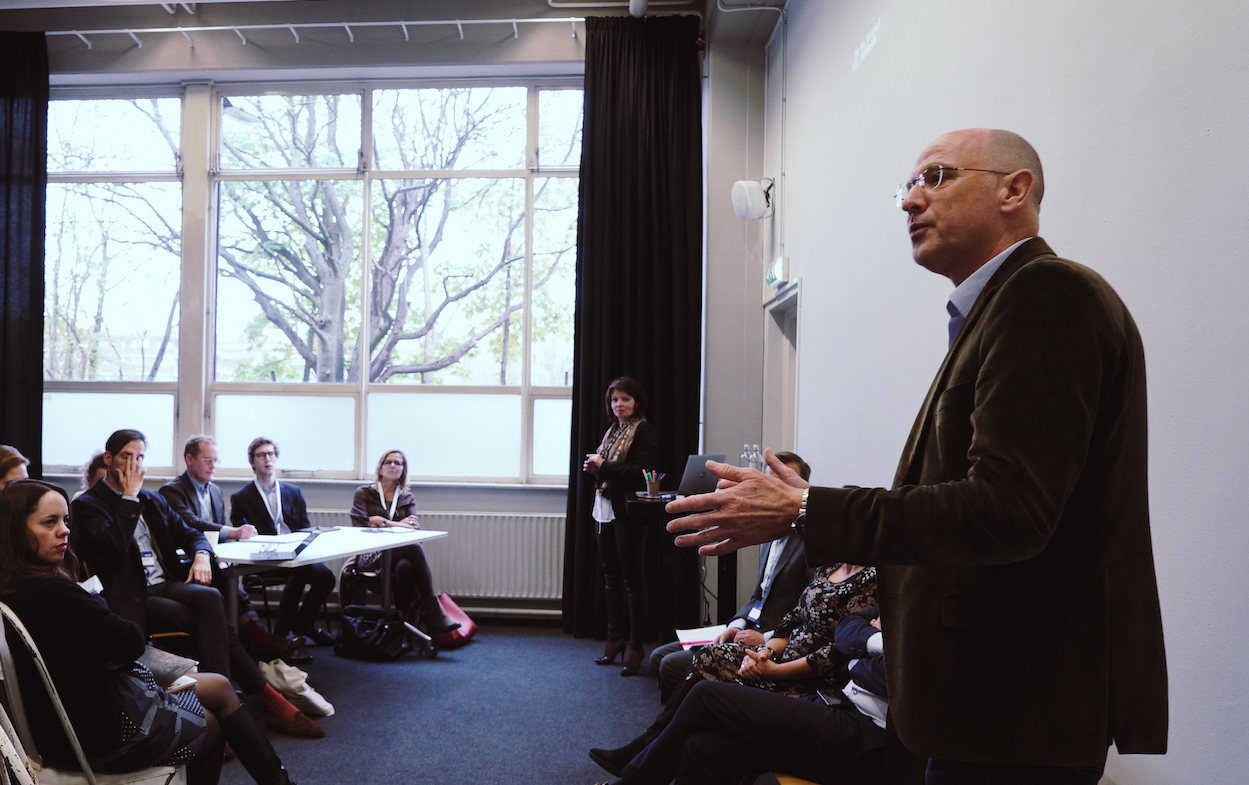From grants to investing – and back again?
What happens when a philanthropic foundation decides to offer repayable finance for the first time? Anything from stronger relationships with investees to “awful situations”, as we heard in a workshop exploring this question at the EVPA annual conference in November. Pioneers Post digs a little deeper...
About three years ago, a grantee of the UK-based Rank Foundation posed an unexpected question: is there scope to repay our grant?
It was the prompt, says deputy CEO Caroline Broadhurst, for an approach that the 50-year-old foundation has since been testing: offering what they call ‘repayable grants’, which average around £100,000. One of these was repaid in full earlier this year, and payments for the others are “looking good”, according to Broadhurst, who was sharing her experience at last November’s EVPA Annual Conference in The Hague. By 2021, it expects to have distributed about £1m in repayable grants (its overall giving averages £6.5m a year).
“A social contract”
The new approach reflects a wider shift at the family foundation, which has a particular niche in finding and backing strong leaders. “‘Profit’ used to be a bad word, a naughty word that we didn’t like to mention,” says Broadhurst. “But we realised that to be sustainable, to be there for the long term, profit has to be in there – whether it’s making money or breaking even.”
Rank Foundation has offered its repayable grants alongside a traditional grant (for example, a repayable grant for buying a property, plus a grant to cover the costs of expertise to manage the purchase). With the first grantee – still an experimental phase – 3% interest was agreed, but since then, grants have all been provided on the basis of simple repayment of the capital (i.e. zero interest) on a timeframe agreed depending on the project. Organisations taking on this finance so far include The Clink Charity (pictured above), which aims to reduce reoffending by training and rehabilitating prisoners.
Repayments are kept in a separate pot from the rest of the grant money, with foundation staff incentivised to keep growing that, but all repayable grants are awarded through the Rank Foundation’s annual grants budget and approved by the same grants committee and board, and subject to the same scrutiny and due diligence as for its traditional grants.
The shift from pure grants wasn’t easy, though. Broadhurst says the foundation’s trustees “really struggled” with the concept initially, and found it more complex to make decisions on offering repayable finance, particularly regarding risk.
‘The reality is payments are coming in so far… [entrepreneurs] are also passionate about their reputation’
If the risk of default appears to be low so far, that’s partly because the funder generally lends to organisations it already knows well, whose leaders have already engaged with the foundation and its network, and contributed to its learning events, for example. And partly, Broadhurst believes, it’s because expectations of free money have moved on: there’s an incentive to repay because “it’s almost like a social contract”.
Asked what would happen if an investee couldn’t repay, Broadhurst says the foundation would “probably let it go and put it down to experience”. But, she adds: “The reality is payments are coming in so far… [entrepreneurs] are also passionate about their reputation.”
And Broadhurst reckons there's value for investees, too: it’s good for accountability and trust, she says. It has also enabled Rank to support organisations it would not have given a grant to – and has meant small organisations unable to afford the higher levels of interest demanded by other lenders can still access finance.
“Too much handling”
Others have less positive experiences to share. Fonds 1818, a Hague-based foundation, began investing (equity, debt and guarantees) in social enterprises and charities in 2008, as well as putting capital into social impact funds.
Director Sanne Ten Bokkel Huinink says they had “a few awful situations” with investees saying they couldn’t pay the interest – knowing that the foundation could afford to drop it and would rather avoid the negative outcome (and publicity) of pushing them towards bankruptcy. “It’s not a fair business relationship,” he says.
And after 10 years, a review of the foundation’s efforts to invest 5% of its wealth into ‘mission-related’ causes, such as social enterprises or charities, found that it had achieved less than 2.5%, partly because it was difficult to find the right investees. The financial return on those investments was negligible.
The issue was partly lack of expertise, says Ten Bokkel Huinink. “It was too much handling… Our people are not experienced in doing investments, and that meant it cost us a lot of time.”
‘Our people are not experienced in doing investments, and that meant it cost us a lot of time’
Faced with the choice of either taking on specialist staff or going “back to basics”, the foundation decided to return to its core focus of grantmaking – but this time also giving to commercial organisations with a social benefit. It’s not expected that such grantees will generate huge profits, but Ten Bokkel Huinink says if they do, the foundation would possibly talk to them about making a donation.
While there’s a focus on companies with a social impact – and the grant would support the social impact aspect specifically – the criteria for such investments are still in development, says Ten Bokkel Huinink, who admits unclear definitions of social enterprise present a challenge. “We’re going to learn by doing.”
Last year, it made its first grant using this approach, of €100,000, to a bakery and restaurant based in The Hague, that employs disabled people and others who struggle to find work. The grant enabled the company to buy essential equipment for a new site.
The bakery has raised other finance from a number of other funders, but Fonds 1818 sees its role as helping to finance the social element, as well as helping convince other investors to come on board. “In general, if we make a big donation, others will follow. They know we are very critical in what we do,” says Ten Bokkel Huinink.
Fonds 1818 has not set an upper limit of how much of its spend would go to profit-making companies, but it’s unlikely to go above 10% of its total spend (€11m in 2020): Dutch law requires foundations to dedicate 90% of their grant funds to supporting ‘common good’, and since it’s unclear if this includes social businesses, foundations tend to avoid taking the risk.
“Not on our own”

Above: Andre Betting, executive director of Van Leer Group Foundation, speaking in The Hague last November.
The Van Leer Group Foundation, also based in the Hague, has two core themes: Israel and early childhood.
It began investing venture capital 40 years ago into firms in Israel – at the time, a relatively poor and agriculture-based economy. The aim was to either reinvest financial returns, or put them into other work that needed grant money. After 25 years, though, the foundation had lost “a lot of money”, according to Andre Betting, executive director – because too many others had had the same idea.
“There we were with our small company, an office of three or four people. We learned, if it’s too easy to make money it’s probably not going to work. Unless you’re a professional investor with a portfolio at least 10 times the size of ours, you’re not going to have the scale, the networks to make actual money.” The foundation now puts its cash into firms that have dedicated Israeli venture funds.
The other part of the foundation’s mission is early childhood, and the organisation did find opportunities to invest loans and equity in an ethical way into this sector. But a combination of not having the right people – “It’s very difficult, culturally, to get people used to making grants to look at a business plan, to evaluate management, to work with lawyers to draft contracts” – and dealing with investees who struggled to meet repayments proved too big a barrier.
“We thought we could have the best of both worlds. We really thought… we’d found a way to make a decent return while at the same time, a clear demonstrable impact. It just doesn’t turn out that way in practice.”
‘We give a loan because we believe it will generate a sustainable impact. If that’s not the case, the entire idea has fallen flat’
Some would argue that as long as positive outcomes have been met, failing to pay interest or even failing to pay off a loan in full is still a good outcome – and financially a better one than a grant that’s 100% written off. But Betting disagrees. “It’s easy to think, the finances didn’t work but the impact is there. But you’ve failed in marrying the two – if you’re focusing on impact only, you should've just given a grant…. We give a loan because we believe it will generate a sustainable impact. If down the line that’s not the case, the entire idea we started out with has fallen flat.”
Van Leer Group has now returned to grantmaking – but Betting is not quite put off impact investing. “We truly think it’s possible to have a sort of revolving fund idea where you make money and either [achieve] impact in the form of grants or reinvest it… we really think it’s possible, it’s just that we haven’t found the manageable format yet.”
The foundation even plans to start a new impact fund. This time, however, it will be with professional partners. “The lesson is, not on our own.”
Combining strategies
So should grantmakers stick to what they’re good at – and leave impact investing to the finance pros?
Not necessarily, says Jamy Goewie, community director at EVPA: those venturing into impact investing ahead of the pack faced a steep learning curve, with few models to follow and a very limited pipeline of potential investees. Still, their experience does suggest that impact investing is “a unique approach” requiring specific skills, and can’t be seen as a simple extension of giving grants.
While combining strategies is still elusive – a 2018 report by UK innovation foundation Nesta found that most funders use just one or two tools “and never seriously consider using other ones which could make their money go further” – there are signs of a shift underway.
Jessica Brown, fund manager at the Barrow Cadbury Trust’s Connect Fund in the UK, points to the emergence of more collaborative efforts – such as the US’s Catalytic Capital Consortium – and says there’s now a “greater understanding of finding the right product for the right organisation at the right time”.
Rather than becoming direct investors themselves, trusts and foundations can also put capital into existing vehicles (such as Resonance’s property funds or in Allia’s charity bonds). And, Brown adds, if impact investing isn’t a suitable approach, grants are well worth continuing: they are, after all, a form of scarce yet vital risk capital allowing high impact organisations to test new ideas.
Goewie echoes this: “I hope the trends in the coming years will not be from grants to investments and back again, but from grants to investments and combining them. To tackle social issues, both strategies are needed in the end.”
Rank Foundation, Fonds 1818 and Van Leer Group spoke about their experiences at the EVPA Annual Conference in November 2019. Find out more about the 2020 conference, on 24-25 September in Porto.
Header photo: Staff at a Clink Charity event at London's Guildhall. The charity received a repaybale grant from the Rank Foundation (photo credit: Clink Charity)



